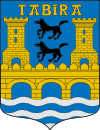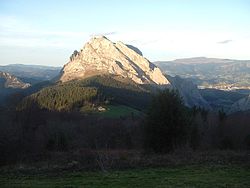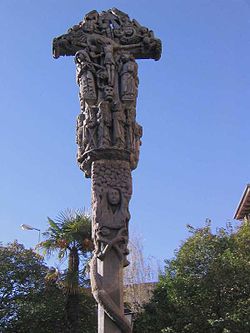- Durango, Biscay
-
Durango — Municipality — 
Coat of armsLocation of Durango in Biscay. Location in Spain Coordinates: 43°10′8″N 2°37′48″W / 43.16889°N 2.63°WCoordinates: 43°10′8″N 2°37′48″W / 43.16889°N 2.63°W Country  Spain
SpainAutonomous community  País Vasco
País VascoProvince Biscay Comarca Durangaldea Founded In the early 13th century Government - Mayor Aitziber Idigoras (PNV) Area - Total 10.91 km2 (4.2 sq mi) Elevation 119 m (390 ft) Population (2007) - Total 27,479 - Density 2,518.7/km2 (6,523.4/sq mi) Demonym Durangar Time zone CET (UTC+1) - Summer (DST) CEST (UTC+2) Postal code 48200 Official language(s) Website Official website Durango is a city and municipality of the historical territory and province of Biscay, located in the Basque Country, Spain. It is also the capital city of Durangaldea, one of the comarcas of Biscay. Because of its economical activities and population, Durango is considered one of the most important cities in Biscay after the ones that compose the conurbation of Greater Bilbao.
It has 26,131 inhabitants (2004). The town is crossed by three rivers (as illustrated in the town symbol) the Ibaizabal river being the main one, and lies in the middle of its wide valley, with the scenic Urkiola mountain range and natural park to the south. The most important peak is the majestic Anboto (1331m).
Contents
History
Durango is a historic basque town. Its name was used by conquistadors like Francisco de Ibarra to found more Durangos in America named after the Basque original one, not least of which is a state in Mexico called Durango, the principal city of which is called Durango.
During the Spanish Civil War, The town was the first place in the world to be attacked by the Luftwaffe, at the request of General Francisco Franco.
Just like the Guernica bombing that followed, it was a busy shopping day - St. Maria, the central church (now a basilica) with a covered market, was the target. About 500 people were killed.
Main sights
Sights in Durango include:
- the Kurutziaga Cross (15th century - currently removed from original site for restoration)
- Baroque Santa Ana's Arch, designed by local architect Juan de Herdoiza (18th century) for the now disappeared line of walls. The arch was constructed to symbolise the town gates, through which the King was required to pass when he visited.
- Mikeldi idol, of pre-Roman times, representing a quadrupedal animal.
- Lariz Tower
Economy
There is less heavy industry in the town than in the late 20th century, as it is being replaced by high density housing projects and shopping facilities.
Durango was for many years the home of Euskal Telebista. This public television company broadcasts in Euskera (Basque) and Spanish. It also has a global presence with satellite channel beamed across the world. ETB has moved to a new headquarter in Bilbao.
Transportation
Bus
Every half an hour there is a BizkaiBus bus service to Bilbao. There are two routes, one via the AP-8 motorway which takes about 30 minutes. This bus runs on the hour. The other slower crosscountry route stops in all towns and takes about 50 mins. There is also a once an hour bus to Eibar, a neighbouring town of a similar size to Durango.
Buses also run to a variety of coastal villages, such as Ondarroa and Lekeitio (from Iurreta, a neighbouring village part of the Durango conurbation). There are direct buses to Vitoria-Gasteiz and Donostia-San Sebastián.
Train
The trains (from EuskoTren company) are narrow gauge and run on a single track. At this time Durango is cut in two by the railway, as level crossings are used, this can cause unexpected delays in traffic. A rail tunnel is being built under the town, that will solve the problem of the level crossings by 2009. Although this is the projected completion date, there is no sign at the moment that this will meet that target.
Trains run to Bilbao-Atxuri station and Donostia and it is possible to get to Gernika and Bermeo also with a train change at Amorebieta.
 The limestone summits of Urkiola, Durango is seen in the background.
The limestone summits of Urkiola, Durango is seen in the background.
External links
- Durango Town Hall
- Urkiola Natural Park
- DURANGO in the Bernardo Estornés Lasa - Auñamendi Encyclopedia (Euskomedia Fundazioa) (Spanish)
Categories:- Municipalities in Biscay
- Populated places in Biscay
Wikimedia Foundation. 2010.





